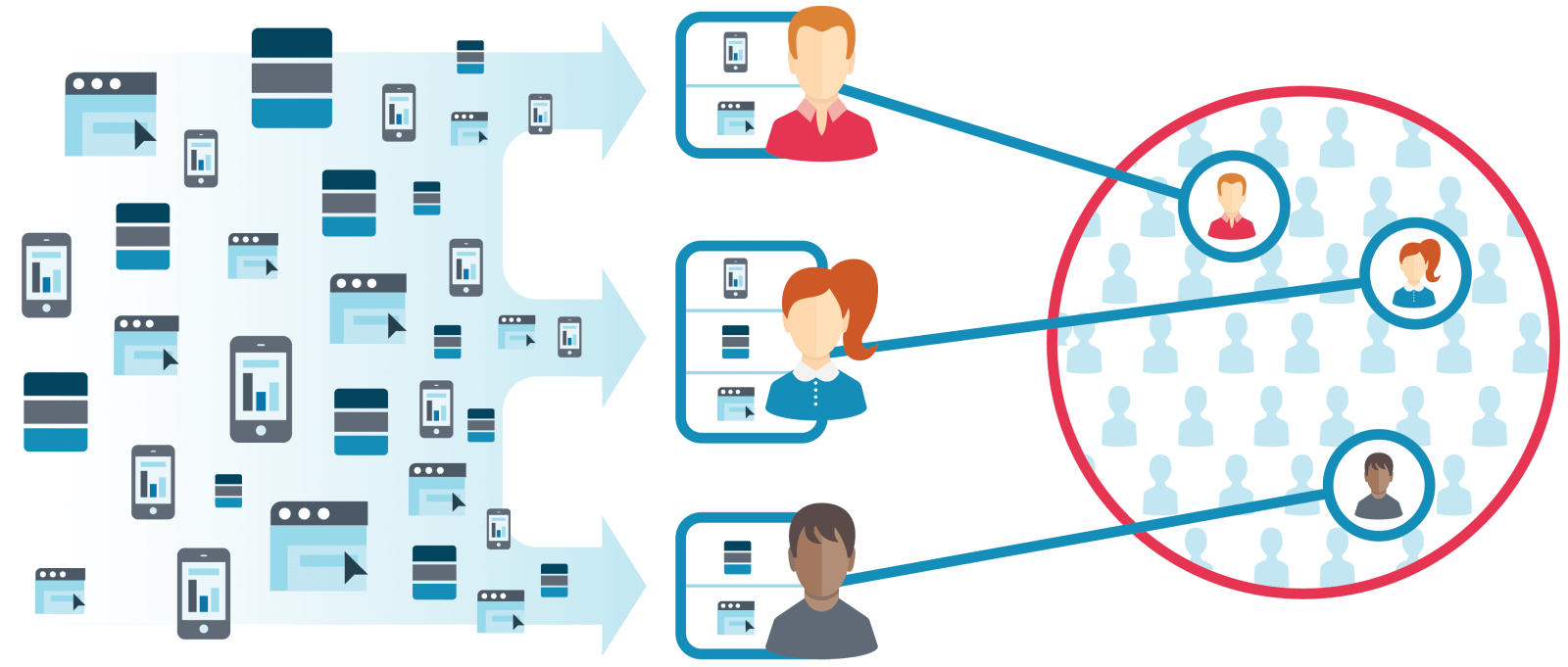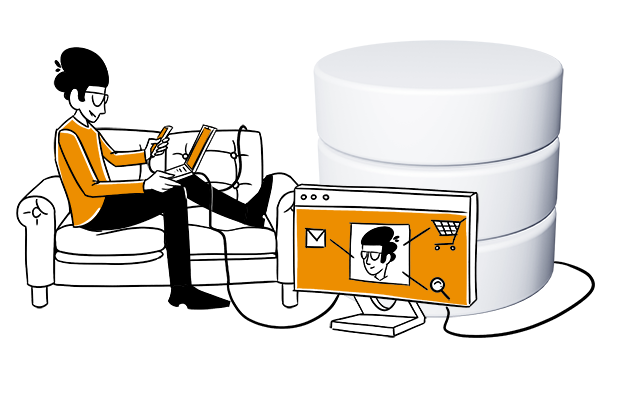Modern marketing is a complex multichannel and multi-device world.
On average, 40% of adult users use more than one device to connect to the Internet. This offers more paths for customer engagement, more ways of making purchases, and more chances to gather data – a myriad of possibilities for both advertisers and customers.
At the same time, it’s a double-edged sword because with these possibilities come challenges. Recognizing users across multiple channels, devices, and touchpoints, then stitching that information into a full dimensional profile is tricky indeed.
Without a well-rounded view of customers, marketing campaigns have to start from ground zero every time a user jumps from one device to another. Understanding customer identity becomes a key point in every marketing strategy.
The question is, how can we achieve this goal with fragmented data scattered across multiple devices? The answer is by using an identity graph (ID graph).
If you’re not familiar with this notion yet, no worries – we’re here to shed some light and provide details on how it can benefit your organization. But before that, let’s take a quick look behind the scenes of graph analytics.
Visualize your customer data
Data scientists, analysts, and marketers all seek the best way to visualize and understand data. The graph method seems to be one of them. You can use graphs to filter meaningful signals from customers, users that otherwise would get lost in the noise of irrelevant data streams.
Graph databases together with linked data present today’s reality, showing us how people live and act. You can employ
- interest graphs,
- customer graphs,
- social graphs,
- product graphs,
- identity graphs,
and many other types of graphs. The power of this technology comes from its capacity to manage links across billions of identities with millisecond latencies.
The core of your graph is a user profile, and the rest is the context you embed it into. You can design one that best fits your organization’s business needs and requirements.
What makes an ID graph?
First of all: what is an ID graph? It’s a tool you use to get a single customer view, not just user likes or interests. It connects all data on individual users across channels and devices. It’s a database. It houses all the identifiers associated with individual visitors. Throughout the whole customer journey you collect various personal identifiers such as:
- Email or physical address
- Account usernames
- Device IDs
- Phone numbers
- IP address
- Cookies
- … and many more
These identifiers are gathered and then sewn together into a customer profile that reflects the ID graph. The graph also contains behavioral data, such as browsing history, past transactions, etc.
The identity graph is fueled by data from different sources, whether it be CRM, marketing and ad platforms, or e-commerce software. In brief, it connects data across the offline and online landscapes.

With all these data points you can create a single customer view that lets you better understand and target customers. The primary focus here is the individual customer, not a device. This cross-device identity is a powerful tool in your marketing arsenal.
What’s more, with the ID graph you gain the possibility to link online data with offline data then reach your customers at every touchpoint. It helps you improve your personalization strategy and lift customer engagement.
Free Comparison of 4 Enterprise-Ready Customer Data Platforms
Get to know 25 key differences between Tealium, Ensighten, BlueVenn and Piwik PRO to find out which platform fits your business’s needs
Why control matters
Connecting the dots of customer identifiers is not the only issue. When you decide to handle a customer’s personal data – which is what some of these identifiers are – you are walking through a minefield of legal issues. That’s why your primary focus should be on data ownership and profile authenticity.
You can acquire ID graphs offered by onboarding providers, ad partners, or social networks. However, this solution means working with third-party data, and that comes with certain restrictions.
First
There’s the matter of legal compliance. The identifiers we’re talking about are usually personal data, which you need users’ consent to process. This might be tricky considering the complexity of data flows between different parties.
Second
When using third-party, a data marketer’s strategy is limited to the capabilities and insights offered by data providers. It might come at the cost of the relevance and precision of information. Consequently, marketers can have trouble measuring their impact and building better relationships with customers.
If you’d like to get a better picture of third-party data, we recommend reading:
Why First-Party Data is the Most Valuable to Marketers
However, there is a solution. You can and even should obtain your own ID graph. Having control and ownership over the graph – over data – your marketing team gets a complete picture of the customer journey.
Because you can achieve cross-screen identification of your users, which means recognizing their preferences, wishes, desires, and past activities, you can finally build well-rounded user profiles.

Authenticated or not?
Visitor profiles come in two types: authenticated and non-authenticated. The former are more beneficial as they’re persistent, being built on authenticated IDs.
They consist of:
- login IDs,
- email addresses,
- customer IDs,
and the like.
Basically, when a user buys something with their credit card or logs on to a site, the identity graph connects the provided first-party data with other pieces of data used to identify this user across devices.
These kinds of profiles grow with every interaction as they accumulate more and more data. The data deepens and enriches such profiles, making them more advantageous for marketing strategies. That’s why the right ID graph must be linked to persistent user profiles.
In contrast, non-authenticated profiles are created from temporary identifiers like cookies, channel- or device-specific IDs that can’t fit into multi-device strategy. Their application is limited to a single campaign or single channel.
When cookies don’t cut it
For years cookies have been successfully used in tracking online desktop users. However, with the proliferation of mobile devices cookies don’t pass the test in this game.
The thing is, on smartphones, tablets, or other similar devices, whenever a user closes the browser, their cookies are reset. They simply weren’t designed for a multi-device reality. They can’t be passed from one device to another, nor be shared between browsers.
What this means for identification practice is that if someone accesses a website on a desktop and then on their tablet, they will be recognized as two different users. So if a visitor comes to your website first on their desktop, and later on their smartphone, that one person will be recorded as two different visitors.
But there are other issues. For instance, the cookies of someone browsing the Internet in incognito or private mode (desktop/laptop) won’t be saved.
And there’s also the trouble with third-party cookies being constantly blocked either by users changing their cookie settings or through privacy features like Intelligent Tracking Prevention. Consequently, cookies are becoming obsolete.
Matchmaking to the rescue
As we’ve already said, when people switch from tablet to laptop and then reach for their smartphones, it means that consumer data is scattered instead of being held on one device. So if cookies can’t do the tracking in the cross-device world, what can you do about it?
You can take advantage of deterministic matching and probabilistic matching. These two methods are applied to match data and help you build cross-device identities of your customers. In this case, there’s no single right or wrong choice.
In a nutshell, the former provides a more accurate match, while the latter offers better scalability. Everything comes down to your business goals and the types of data you have access to. You may even find instances where they compliment each other and you can apply both. But before you decide, let’s dive into the details of each.
Deterministic matching
Deterministic matching lets you recognize the same person across multiple devices by matching the same user profiles together. These profiles are built around various bits of user data with every user having their own profile on different devices.
To recognize users across multiple screens, deterministic matching searches through data sets and ties all profiles of a particular user together with a common identifier. The matching is usually achieved through login details.
For instance, if someone regularly types in their username and password into a site using their mobile phone, the brand recognizes this user profile and can link the user with this particular smartphone and also identify that same user if they then login using the same credentials on a different device (for example, their laptop). It means that the data is authenticated, which significantly increases its certainty.
One of the biggest assets of this method is its accuracy (about 80-90%). However, when it comes to scale, it’s not the best option, because not all websites or applications compel users to log in or submit other information.
Probabilistic matching
If you’re looking for better scalability, you can use probabilistic matching. It utilizes distinct data sets (as mentioned earlier) together with algorithms. Thanks to this formula you can identify the same user across the whole multi-screen digital landscape. Probabilistic matching uses data like:
- IP address
- Device type
- Browser type
- Operating system
- WiFi network
- Location
This method creates probable statistical connections between a user and any number of devices they use. Compared to the deterministic method it’s not as accurate, but it applies the same data sets to teach the algorithms to increase accuracy.
One of the key advantages in this approach is scalability, providing organizations with greater possibilities to scale personalization beyond their user base.
So you’ll be able to recognize users across multiple screens without having to gather email addresses or other personal data.
However, the drawback of probabilistic matching is poor transparency of matching methods and algorithms.
Another difficulty which appears with both methods are the privacy issues present on the legal landscape. If you want to process personal data, including IP addresses, you need to make sure you do it in compliance with regulations like GDPR. In other words, you have to obtain a user’s consent to proceed.
Why you need ID graphs
Now that you know the ins and outs of ID graphs, it’s time to have a look at how this technology can be of benefit to your organization. Since ID graphs stitch customer identities into a single customer view, they provide you with an array of potential applications. Let’s review the most important ones.
Optimizing personalization
In a personalization strategy the key focus is on identifying the user. To be precise, knowing about their preferences, desires, and wishes, and then providing them with content that truly resonates. ID graphs help you achieve this as you get the full dimensional customer profile that blends the online and offline worlds of their interactions with your brand.
Understanding each user and customer at the individual level allows marketers to provide more engaging content. In addition, you can constantly enrich and update identity data to optimize the results of your marketing campaigns.
Take the example of giants like Amazon or Netflix that serve the most relevant product recommendations. They take advantage of ID graphs tracking browsing history across users’ devices to serve highly engaging recommendations.
Addressing customer needs in real-time
The digital world speeds up all user interactions. This trend forces marketers to recognize and meet customers’ requirements without delay. It means organizations need real-time technology to gather, match, and activate data.
Enhancing customer engagement
Thanks to the capacity to match offline data with digital identifiers and behavioral data within ID graphs, marketers are able to better engage with customers. With well-rounded customer profiles you can predict their future needs, plan strategies, improve up-selling and cross-selling campaigns, and find better opportunities to re-engage lost customers.
Improving cross-device attribution
By taking advantage of deterministic identity graphs, you can identify the role every channel performs in user conversion. Once you have a bigger picture of the customer journey you’ll be able to accurately attribute conversions.
You can tailor messages to each customer individually and reduce budget waste resulting from generic campaigns. Your aim is to ensure that customers engage with your content in an optimal way no matter how often they jump from one device to another.
Free Comparison of 4 Enterprise-Ready Customer Data Platforms
Get to know 25 key differences between Tealium, Ensighten, BlueVenn and Piwik PRO to find out which platform fits your business’s needs
Final thoughts
Companies operating within the digital ecosystem need to shift their focus from customers’ actions to customers’ identities. To achieve this goal, they should wield technology across multiple screens and channels to create direct relationships with their users. An optimal solution like ID graphs lets marketing teams keep up with customers who expect immediate and relevant brand experiences across all touchpoints in their multi-screen journey.
Although we’ve just scratched the surface of the complex topic of identity graphs, we hope you’ve found some key solutions to tough issues. If you have any questions, reach out to our team and we’ll be glad to answer them without delay!










